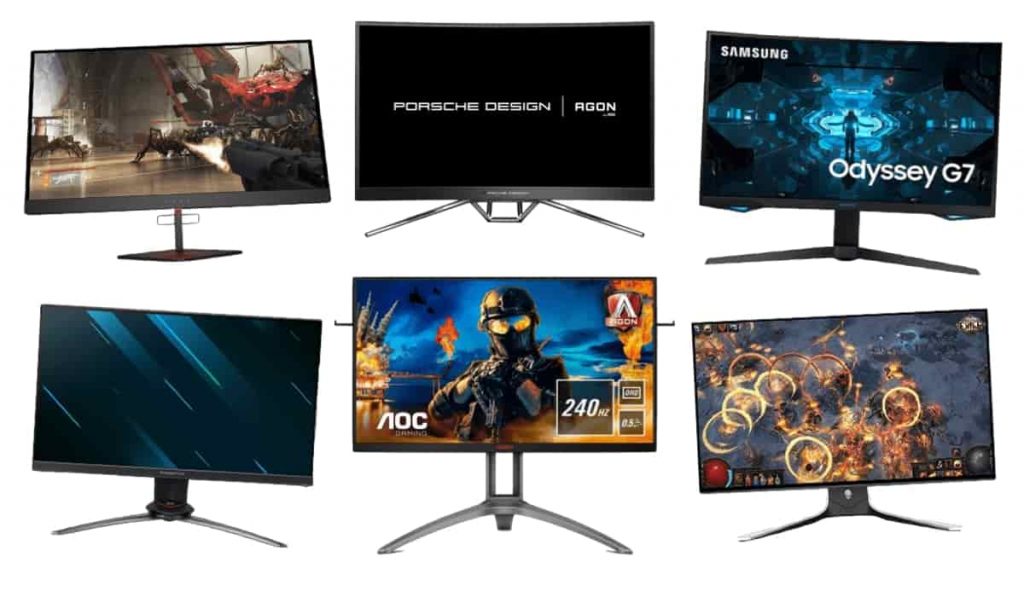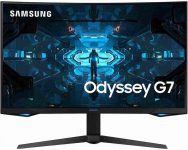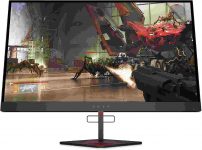For both PC as well as gaming console owners, a good monitor is a crucial element of gaming. When we think of PC design, we usually forget the important role that the gaming monitor plays. They are the gateway into the game and a good panel is crucial to give you a complete gaming experience.
It is feasible playing PC games using a standard display or an old TV, for optimal results, you must look into a gaming-specific monitor. The standard monitors are an unfavourable combination of low-resolution panels and a low refresh rate.
For those who aren’t familiar, the term “refresh rate” refers to the number of frames that the display is able to physically display. This is also the highest FPS that you can get when playing games. A panel with 240Hz is able to refresh up to 240 frames per second. Panels with high refresh rates provide smooth motion and permit users to experience somewhat faster reflexes for competitive shooters.
Here are seven of our best options to choose your 1440p 240 Hz gaming monitor.
7 Best 1440p 240Hz Monitors: Go-To Buying Options
| Ranking | 1440p 240Hz Monitors | Reviews | |
| 1. | Samsung Odyssey G7 | 5 out of 5 | |
| 2. | Alienware AW2721D | 5 out of 5 | |
| 3. | HP Omen X27 | 4 out of 5 | |
| 4. | ASUS ROG Swift PG279QM | 4 out of 5 | |
| 5. | Samsung Odyssey G9 | 4 out of 5 | |
| 6. | BenQ Zowie XL2546K | 3 out of 5 | |
| 7. | Dell S2719DGF | 3 out of 5 |
Best 1440p 240Hz Monitors | Detailed Review
1. Samsung Odyssey G7
Samsung Odyssey G7
2. Contrast Ratio: 2500:1
3. Aspect Ratio 16:9
The Odyssey G7 from Samsung is one of the top gaming monitors you can find despite the plethora of complaints from customers. The flickering issue has been fixed by a firmware upgrade, but there’s a good chance that you’ll receive a monitor with additional problems. However, the majority of PC monitors today (including the three IPS selections) are plagued by poor QC.
If you purchase any of the models on this list will also include an involuntary lottery entry. G7 is a top performer across all areas. The response time is astonishing for the price of a VA panel and the monitor does not suffer from slow response times in lower refresh rate (60-120Hz).
Colours are excellent and accurate with gamut coverage that is slightly behind our IPS selections, however, out of the box accuracy is better than average and the contrast is better in comparison to the other models that we have included, except it being the Odyssey G9. Maximum brightness is 600 nits which is a good amount, with HDR performance being superior to that of many other 1440p models with 240Hz. The G7 also has support for FreeSync as well as being G-Sync compatible. Another advantage of this particular model is the fact that it’s offered in both 27- and 32-inch versions.
The biggest drawback to IPS panels is the small viewing angles. However, the curvature of the panel can be a big problem for some people, but should you not mind it, this panel is an excellent option. Particularly for games within the 60-144Hz frequency range.
2. Alienware AW2721D
The ideal size for a resolution of 1440 pixels is 27″ and Alienware Aw2721D delivers exactly this. The display has one millisecond response time which is great for gaming in competitive situations. Nvidia G-sync’s feature ensures your monitor’s frequency as well as the FPS associated with your Nvidia GPU are in sync, ensuring that there’s no tearing across the display.
LED-backlit LCD monitors / active matrix TFT ensures that the contrast ratio is 1000:1. This ensures that you can see black as pure black. The monitor comes with an audio jack that can be used to allow for old-fashioned 3.5mm headphones. Although the monitor is designed for gaming, certain features would be an ideal feature. A monitor designed specifically to gamers lacks characteristics that make a premium monitor.
The RGB light appears as an incredibly thin ring with an image, which is very minimal for this screen. The monitor is as plain as they can be; there’s no laser logo, nor is the sleek body design that looks attractive. The monitor is intended to be used for commercial use. The crosshair feature is also not available for this display. The monitor isn’t compatible with AMD Freesync out of the box, however there are a few workarounds to enable it.
Alienware produces high-end items that are well-balanced in performance and are worth the price. The devices have long performance and last according to the specifications. The dark stabiliser for gaming is a great way to find enemies in dark places. There are quick presets, ultra-fast, super-fast, and extreme settings to get the highest response speed. This option will help lessen ghosting and motion blur – 95 percent of the DCI-P3 colour spectrum using Nano IPS technology. The features that are balanced on this gaming monitor place it among the top 1440p monitors with 240Hz.
3. HP Omen X27
If you’re looking for TN 1440p 240Hz monitors, the most effective one is the HP Omen X27. It’s got great colours for a TN monitor and covers 100% of the sRGB colour spectrum and approximately 75% of the DCI spectrum of P3. Great for gaming & solid for content creation. The contrast is moderate, about 800:1. The maximum brightness is around 300 nits in each SDR or HDR. The brightness is not the best, but it’s enough to be suitable for rooms with good lighting.
Response time is exceptional across all frequencies, but especially when you play between 60Hz and 144Hz. Omen X27 is FreeSync and G-Sync compatible. The downsides are that ergonomics aren’t ideal, colour performance is below the other options, and viewing angles aren’t quite good. This is typical for a TN panel, but it’s not as good as our other choices.
The great thing is that although the Omen X27 isn’t a budget model, it’s still not a proper budget model, it’s closest to an affordable 1440p 240Hz monitor. Overall, it’s an outstanding high-refresh speed gaming display. The presence that it has a TN screen is a disadvantage to it when compared with both display models with IPS as well as those with G7 & G9 models with the VA panel, but for gaming, this is an excellent option.
For alternatives, you can choose an alternative to the Lenovo Legion y27gq-25 that has more brightness and faster response times, but it’s very expensive for the price of a TN monitor. Instead of Lenovo, choose either of the IPS monitors listed here or one of the Odyssey G7 & G9 monitors.
4. ASUS ROG Swift PG279QM
ASUS ROG Swift PG279QM
2. Contrast Ratio: 1000:1
3. Aspect Ratio 16:9
ASUS introduced its ROG Swift PG279QM which was the new leader of the market for 1440p at 240Hz. While it’s not as fast in response time like it is the Odyssey G7, the PG279QM is superior in all other areas. First off, the PG279QM isn’t slow. It’s only a little slower than the G7 in terms of response time. In general, it’s one the most responsive IPS monitors available.
In addition, its colour performance is stunning, with excellent factory calibration right out of the box and 96% coverage of DCI-P3. Also, you can carry out professional video and photo editing with this monitor without any problems. Additionally, you can utilise it with the Esports overdrive mode throughout the refresh rate range due to G-Sync Ultimate Support. This is a great benefit since the majority of VRR monitors do not have an overdrive mode that can be used across all refresh rates.
The best part is that you can utilise AMD cards for this monitor as it is also equipped with full FreeSync support. The wide gamut capability is enhanced by a fantastic sRGB option that lets users enjoy normal (non-HDR) content with no oversaturated colours. This is an enormous benefit considering that the majority of wide gamut monitors don’t have an sRGB option or do not allow adjustments by the user. The IPS panel offers great viewing angles, but also has a typical contrast (about 1000 to 1).
The max brightness is decent but it’s not among the best as it is only around 350 nits. But the 380 nits ought to be sufficient to use the monitor in brightly lit areas regardless of whether the sun is directly hitting the panel. This monitor’s HDR support is basic , and as with most gaming monitors it’s best to use the monitor in SDR mode. Overall the PG279QM is an excellent gaming monitor that is ideal for professional gaming and color-critical work.
We Believe you are a Gaming Enthusiast, You Might like, 4k 144hz Monitors
5. Samsung Odyssey G9
Samsung Odyssey G9
2. Contrast Ratio 2500:1
3. Aspect Ratio 32:9
If cost is not the main thing you think about and all you desire is the best gaming monitor available with the most advanced features technology companies could include into an enclosure, then the Samsung 49″ Odyssey G9 is the ultimate gaming monitor that you can buy. The huge 49″ screen with 5120 pixels by 1444 pixels is a fantasy.
Its G9 series is right on the mark and has no flickering when using sync-to-sync technology and the amount of depth and detail you will get through HDR 1000 support HDR 1000 support is unparalleled. The brightness ratio of 2000:1 for an LED panel is incredible. It’s the most ultra-wide 1440p 240hz screen on the market. Even though it’s a premium-quality monitor, the power button is an analog and has been observed to become ineffective over the passage of time.
The monitor cannot be switched on and off; the user should be aware of how resolutions work as well as colour depth effects due to the increased refresh rates. Many users may require a reference to this manual as well as YouTube to achieve the 240Hz refresh rate functioning. The monitor can get quite hot in 240Hz as well as 1440p resolution since it demands a huge amount of processing power. The monitor is quite heavy and the stand isn’t doing enough justice to the monitor.
For aesthetics, it is the most clean monitor on the market. Don’t be afraid to showcase the custom Infinity Core lighting at the rear of the screen; it is enchanting in its own right. The size of the screen is equivalent to two QHD monitors positioned next to each other. G9 is a full battle station in one screen. It is the only monitor that can even come as close to its capabilities. Also, the display is incredibly bright at 1000 nits, due its LED lighting
6. BenQ Zowie XL2546K
BenQ Zowie XL2546K
2. Contrast Ratio 1000:1
3. Aspect Ratio 16:9
If you’re a typical player and you want a 1440p 240Hz gaming monitor display but don’t want to shell out for the price of premium, opt for one of the 1440p models that run at 165Hz. The difference won’t be noticeable while gaming, or even playing games with esports in them. If you’re a semi-pro player seeking a reasonably inexpensive 240Hz monitor, but aren’t able to afford the price to purchase a 1440p model, Get an XL2546K model from BenQ.
This monitor has incredibly slow response times using ULMB as well as surprisingly good quality of colour and excellent ergonomy. One of the most important aspects, in this case, is image clarity. It is clear that the DyAC+ tech is seriously capable, providing unbeatable image clarity and virtually no blur.
The disadvantage is that, as with the majority of other screens, it is not possible to make use of ULMB when you are using VRR, however if you’re playing Esports games, chances are that you won’t experience screen tearing while playing at high-speed 240fps. For single-player games, you can disable DyAC+ setting.
7. Dell S2719DGF
If you are looking for a monitor that can do the job with a minimal cost and high performance, Dell S2719DGF is the most efficient monitor available on the market. It doesn’t have the flashy RGB as well as Logo Holograms but it is equipped with an excellent AMD FreeSync capability. The build quality rated by customers is top-notch and the entire assembly feels solid and durable.
The monitor functions as an USB hub, with four USB Type-A ports that are available to users. The monitor is equipped with 2 HDMI ports, however only one is compatible with HDMI 2.0. The monitor also comes with an HDMI display port which is the ideal choice for connections to monitors. As a TF-based panel, the viewing angles aren’t sufficient; however, if you’re gaming, you’re more likely to be sitting close to the screen, so the angles of the screen won’t be a primary concern.
The contrast of this monitor isn’t very excessive, and some users have found results of 890:1 with local dimming being enabled. The monitor is not compatible with HDR. The display has excellent luminescence, with 386cd/m3 and won’t rapidly dim in the midst of a bright room. The refresh rate of the monitor is as high as 155.5 Hz in overclocked conditions.
Factors To Keep in Mind Before Buying Best 1440p 240Hz Monitors:
1. Panel Type
The presence of an IPS or an LED can impact the look of your game. IPS is generally gentle to look at and has greater refresh rates easily. LED panels are light and have high contrast ratios. However, they can cause strain on the eyes even though they have lower refresh rates.
2. Resolution
Resolution is a big factor when talking about the display screen since everything you can watch in a display is constructed out of thousands or millions of tiny squares, referred to as pixels. The resolution of the screen determines the amount of pixels your screen will display. If you own a screen with 1440p resolution, the screen will appear pixelated. If you choose an extremely small screen, it will be missing the finer specifics. Make sure that you choose the right dimension.
3. Response Time
This is the most crucial aspect for gamers. It is the time it takes for the monitor to respond to the signals transmitted through the GPU. It must be in the range of 1 milliseconds. Don’t worry about it because we’ve featured monitors that provide the fastest response time.
4. Adaptive Sync
This is an important aspect because the amount of times that the screen refreshes correspond to the number of times your graphics cards transmit the signal. The screen’s refresh rate in line with the frames generated to your GPU is called adaptive sync. This feature greatly affects displays that run at 240Hz.

FAQs
Q1. Which monitor size is best for monitors 240Hz 1440p?
The ideal size for 1440p 240Hz screens are 27 inches. A 27-inch 1440p 240Hz monitor is characterised by a high pixel density that ensures a brighter and clear image display. Although 32 inches aren’t the best size for 1440p monitors with 240 Hz however, it’s a great option for gaming due to its wide view that gives you a full perspective.
The size of your monitor should be based around resolution and the distance of the monitor with your position. Ideally an 240Hz 1440p monitor or smaller options will utilise 1080 pixel display resolution. A 27-inch screen is best suited to resolution of 1440 pixels and anything greater than 27 inches will need an image resolution of 4K or higher.
Q2. When it comes to the best 1440p 240hz monitors, what is the best response time?
The most responsive speed for a 1440p 240Hz display is 1ms. This is also known as 0.5ms Moving Picture response time. Response time refers to the amount of time required to allow your monitor to react to a trigger movement, input or request. The response time is crucial particularly for gaming monitors. The time it takes to respond is crucial for the smoothness of gaming since it determines whether your monitor will suffer from motion blur or image ghosting. It’s a key aspect of competitive gaming and is the thing that professionals take into consideration when choosing gaming monitors.
Q3. Can 1440p 240hz monitors be used for gaming?
Yes, 1440p monitors with 240Hz can be used for gaming. A 1440p 240 Hz gaming screen provides high resolution for a clear display during your gaming experience. You can also try checking out Best 5 Affordable 240Hz Monitors compatible for Gaming on higher Refresh Rates without lagging behind others.
The refresh rate of 240 Hz is far too high compared to most requirements for gaming’s refresh rate. For instance, Apex Legends requires 1440 pixel resolution and 186 frames per second. High refresh rates can make games more responsive and more enjoyable. With a 120 Hertz refresh rate can make your game more fluid. But, the top 1440p gaming monitor with 240hz refresh rate will require you to be able to achieve a frame rate of at least 144 FPS. Best 5 Affordable 240Hz Monitors

















